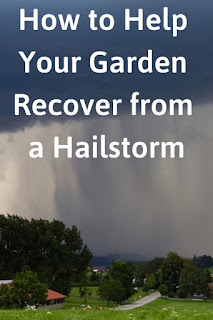You plant your garden in May, and by June it is looking perfect. The first blooms are on the peppers and tomatoes already. The nice afternoon showers are watering your garden and then it happens. An intense hailstorm hits and you get home and look at the hail piled in your garden like snow. Now, what do you do?
Your Garden Can Recover From a Hailstorm
When this happens, every gardener has to decide whether to replant the vegetable garden or try to mend the hail damaged plants. You have to consider the time of year the hailstorm happens and if there is time to replant the vegetable garden.
If the hailstorm happens early in the growing season, you can replant the garden if needed. In some areas, the growing season is not that long and helping the hail damaged plants recover is the best choice.
How to Mend Broken Stems
Any broken stems or branches should be cleanly cut off. Cut the broken branch right at the break point or about 1/4 inch below the break (closer to the main stem).
Look for any stripping of that branch below the break point and cut the branch where the stripping ends. Some branches might just be bent downward and not broken. You can prop them up with small sticks and they should soon turn towards the sun and start growing again.
You might see small white spots on the branches where the hail hit them. Don’t remove them yet as new branches could grow from them. You can reassess those branches in a week or two.
Hail Damaged Leaves
Leaves can be split, have holes in them or totally destroyed. Takes off the leaves where there isn’t much leaf left. With leaves that are just split or have holes in them, leave them on the plant. They provide food for the plant and will help the plant recover if left on.
Fertilize the Garden Plants
After cleaning up the damage to the plants, they will need to be fertilized. This will get the plants growing again and help ward off disease.
There are several good fertilizers to use including chemical fertilizers such as Miracle-Gro, Ferti-lome or any other good vegetable fertilizer. With any chemical fertilizer, make sure you follow the directions so the vegetable plants are not burned.
An excellent organic fertilizer for vegetable plants is fish emulsion mixed with kelp. Kelp is the same as seaweed and is soothing to the plants and works well as a fertilizer when mixed with the fish emulsion.
A recommended brand is Neptune’s Harvest fish/seaweed blend, which I found at the garden shop and is also available online.
Watering evenly is also important, don’t soak one day and then forget it for a week. Keep the garden evenly wet.
 |
| © Sam Montana |
How to Protect Your Garden from Hail
Maybe the night before the weather service is predicting a good chance of hail for tomorrow and you know you should cover your garden. Or there is a hailstorm coming and you look around for items to cover the garden with.
I’ve been in that situation many times and moved patio furniture, boxes or whatever else was handy to cover parts of the garden.
There is a new item on the market called a hail cloth or anti-hail netting that is made from High-Density Poly Ethylene (HDPE).
It is fairly easy to install and could be worth it if you live in an area where hail storms are a threat to your garden. The best way to use anti-hail netting is to put stakes taller than the garden plants and lay the hail cloth on the stakes above the plants.
Should You Replant Your Vegetable Garden?
If the hail damaged the vegetable plants too much, you might be able to replant the vegetable garden with large enough plants depending on your planting zone and the time of year the hailstorm occurs.
Hail Damaged Flowers
Hail Damaged Trees
Inspect the bark of shrubs and trees to make sure there isn’t heavy damage to the bark itself from the hailstones.
Conclusion
One week later, I was seeing plenty of new growth and blooms on the tomatoes, peppers and other vegetable plants.
© 2009-2018 Sam Montana


No comments:
Post a Comment